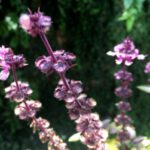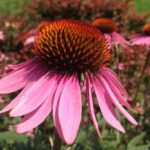hybrids
In the world of plants the word hybrid immediately brings forth a specific image: greenhouses filled with long tables covered in little potted plants, perfectly tended to by a diligent team of professional growers and fed a perfect blend of nutrients to optimize their development.
The truth is plants mastered hybridization long before gardeners decided to use it to their own advantage, and they practice it enthusiastically and to quite interesting effects. For instance, I assume this phlox’s corolla gradient is the result of the purple variety combining with the more recently planted white one.
If, like many gardeners, you prefer to stick to a single perennial for a more cohesive landscape design, you’ll be in for a treat in a few years. The descendants of your original plantings will end up boasting every color imaginable, some of which seem impossible to obtain from the available selection.
Happy to be left to their own devices the plants eagerly scrub their genome to retrieve forgotten traits from two, three generations back, and combine them to produce outcomes that boggle the mind.
The first generation of offspring kind of makes sense if you spend some time trying to figure out how it came to be, but after that it’s nature’s choice. That’s how I ended up with lavender phlox and deep rose hellebores.




 Previous Post
Previous Post Next Post
Next Post




